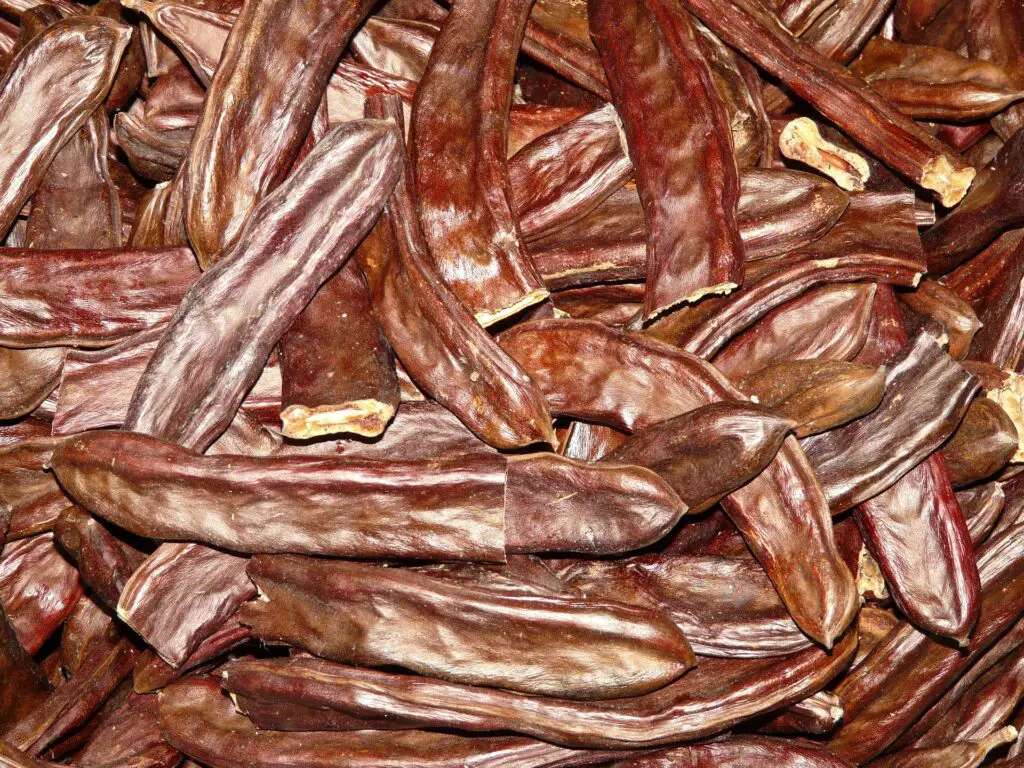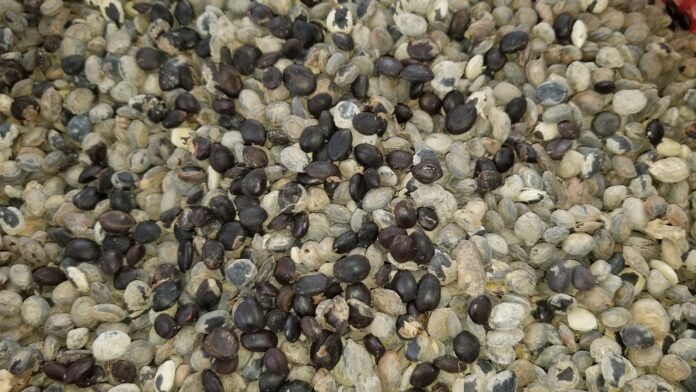Some links on this page may contain affiliate links which means that, if you choose to make a purchase using the link, Agricfy.com may earn a small commission at no extra cost to you. For more information, go to our Affiliate Disclosure Page!
Introduction
African Locust beans pod is an end result of the tree called Parkia biglobosa popularly found in Africa.
The pod is well known to give a delicious taste to any meal used for cooking.
Also known as Iru (in Yoruba); Ogiri (in Igbo) and DawaDawa (in Hausa) are commonly accepted although some people hate them for their smell before being put into soups.
The tree has some economic benefits besides the seed being used to cook and drink.

Many people get to see the finished product of Parkia Biglobosa but never have the opportunity to know how it is being made.
Read more about Parkia bioglobosa HERE. Parkia biglobosa
In this article, I will be telling you how to make locust beans, the ingredients used, the fermentation process, and so on
Different Names of Locust Beans
There are different names given to African locust beans depending on which part of the continent you come from.
If you are from Nigeria, locust beans are called Irú in Yorùbá, Ogiri in Igbo, and Dawadawa in Hausa.
Every country has its unique name for locust beans, do some research and get familiar with them.
Benefits of Eating Locust Beans
African locust beans have been proven over time to be good for consumption because of their health benefits. Some of which you might know and some you haven’t heard before.
Here, let’s look at the benefits of eating locust beans.
i. Improves Eye Sight
The first benefit of eating locust beans is it helps improve sight.
When I was younger, I was told to always eat locust beans as it would help me with my eyes, which I can confirm now that it has helped.
This has been proven medically as to why people should eat locust beans. So, if you want to have good eyesight, or want to improve that of your younger ones, encourage them to eat locust beans regularly.
ii. Helps Control Blood Pressure
The second benefit of eating locust beans is it helps control blood pressure.
Many Africans suffer from hypertension cos of the nature of work being done in this part of the world and also cos of overthinking. If you know anyone who is suffering from high blood pressure, advise them to start eating locust beans.
DISCLAIMER: Depending on the severity of the case, it is possible it doesn’t work for everyone. If it is still in the early stages, it is advisable to start eating locust beans.
iii. Helps With Weight Loss
Another benefit of eating locust beans is their ability to help during your weight loss journey.
Just like every other fruit, the locust bean gum contains soluble fibre which helps control sugar levels and reduce weight.
iv. Help Control Diarrhea
One of the many benefits of eating locust beans that most people don’t know of is the fact that they control diarrhea. Yes, you read it well, locust beans control diarrhea.
The African locust beans contain tannins which can also be found in some tea, red wine, coffee, and some fruits.
How do you use this to control diarrhea? Cook the locust beans like a meal.
DISCLAIMER: Because others have to use locust beans to stop diarrhea doesn’t mean it will work for you. Its effectiveness depends on how you prepare it.
Side Effects of Locust Beans
There is a popular saying “Everything that has an advantage will definitely have a disadvantage”. No matter how good something is, it must have its own side effect except you didn’t check well.
They say too much of everything is bad for the body. Taking too many locust beans can lead to purging which is a major concern for the health if not taken care of well.
Another thing to be wary of is that if you have some terminal disease, it is better to run away from eating locust beans.
I will advise you to ask your Physician/Doctor for better knowledge on this.
How To Make Locust Beans

You might want to make locust beans at home for consumption, or for commercial purposes, reading this article will guide you through the process it took us to make locust beans without stress (although it is stressful to make).
This whole process took us approximately 6 days to complete; from the first step (boiling the seed) to the last step (which is packaging).
Pay critical attention to how we made the locust beans also attached at the end of this article is a video that shows the processes.
1. Get The Seed and Boil For 16 Hours
The first step to making African locust beans at home is to get your seed.
The seed can be bought in any local store. If you want to get the seed in bulk and even cheaper, it is best you go to rural areas to buy them. States like Oyo, Osun, Ekiti, etc are places where you could get this seed. It is called “Ìyere” in Yoruba.
In order not to get scammed, you can Contact Me to help you with it.
After getting the seed, boil the seed in hot water. The whole boiling process takes between 16-24 hours. WHY? This is to make sure that the seed gets soft and makes it easy to peel.
It is possible to boil for 24 hours and yet the seed doesn’t get soft depending on the kind of seed you buy. When this happens, it is important to keep boiling.
I know you’re thinking about how much will I make, that I will be wasting my gas just to make this happen. Well, I will advise you to either use charcoal or wood to process the boiling in order to save cost. It is a cheaper option.
If you use charcoal to boil the seed, it is easier to manage resources even though it is easier to control the level of fire that is being used if you’re using gas cylinders.
2. Dehulling
The step in the process of how to make locust beans is to peel the seeds. This process can be simply put as dehulling.
This step is one of the most stressful parts of the whole process especially if you’re doing it manually.
Depending on the quantity of seeds you boil in the first step, it can take you as much as 8 hours to finish peeling the seeds.
If you’re not doing this mechanically, it can be stressful cause it requires leg work.
The first time we did this, I couldn’t feel my leg for like 4 days cos we kept matching and matching in a way to peel off the seed.
I also fell during the process of peeling. We peeled the seeds manually. There are some people that use mortals to peel the seeds as well.
Whatever method you decide to use, make sure you do this process well and peel the seeds thoroughly.
3. Wash
The next step in the process of making locust beans is washing. The reason why we are washing the peeled seeds is to make sure that the dirt and possibly stones might have mixed with the seeds.
This doesn’t take time as it is just for you to wash away dirt. You use a local sieve to make this process a little bit faster.
4. Pick The Seeds
After washing the seeds with cold water, the next step in making locust beans is peeling and picking.
This process also takes time because it will be done manually. What are you picking exactly?
There will be some stones and maybe locust bean seeds that didn’t cook well. It is this time you have to pick them out. You need to do this carefully without rushing, you don’t want to eat/sell bad locust beans.
When I did our first experiment, we spent like 4 hours picking the seeds (we were three that picked the locust beans).
5. Ferment It (Put into hot water)
We are getting closer to getting the desired result – Locust beans. The next step to how to make locust beans is the fermentation process.
This is the longest step in the process of making African locust beans. The fermentation process takes 2 – 3 days depending on where you want to ferment it.
What is fermentation? Fermentation is the process of breaking down sugar/food into smaller microorganisms by enzymes without enough air. During the fermentation process, you will first pour the picked seeds into hot water again, and let it cook for like 3 hours. Remove the seeds from the water, sieve them, and make sure there is no water in the seeds at all.
Proceed to spread it on an item like a tray, bucket, or any other thing, and cover the tray well.
Make sure there is no space for air to enter where you poured your locust beans.
NOTE: This process is the most important because if not done well, it can render all your efforts useless. You could get every other step wrong (in a way) but you must not get this particular step wrong. Any small mistake here, then money, time, and effort are all gone.
As I mentioned earlier, the fermentation process takes approximately 3 days to complete.
6. Start Selling/Packaging
After the fermentation process has been completed and if everything goes well, then you can proceed to package your locust beans. Before packaging, you know you have to unwrap the locust beans, bring them out of the room you covered them, and spread them outside for fresh air. At this point, nothing can really happen to it.
NOTE: You need to add salt to it so it doesn’t get spoilt easily.
Following all the processes mentioned above does not mean it will come out well, but you are guaranteed that there is something good to come out of it. Even experts get bad results sometimes, so if it doesn’t come out well the first time, try again till it gets better.
There are so many reasons why the African locust beans might not come out as expected. Two of these are:
i. Bad seeds
ii. Wrong fermentation process
Conclusion
Our first attempt at making Locust beans (Iru, Dawadawa, Ogiri) was a bittersweet experience for us on the farm because we made mistakes, we fell and some parts of it didn’t come out well. It is stressful to make, and if you’re not doing this to make money, then I will say don’t bother trying it.
Just to recap, the process of making locust beans is:
- Get the seeds
- Dehull (Boil and Peel)
- Wash the boiled seeds
- Pick The Seeds
- Ferment for 2-3 days
- Package Your Locust Beans
There you have the steps on how to make locust beans at home. I would like to know, will you try this on your own or you will pass?
Engage me in the comment section.

Would you be inquisitive about exchanging links?
Can j add potash to quiken the process.
You can add Ashes instead. That is what my grandma uses
What can I add to make it soft on time. For example potash is added to soften Bean
Thanks for the information. You said it should be boiled for 16 – 24 hours, the first time I boiled it, it was ready for peeling within 3 hours. Is the 16 hours include the whole boiling?
Then during the fermentation period, it was just two day and it over fermented. What should I do?
I did all that requires and I fermented for two days and is already over fermented, what could really happened. Where did I get it wrong. Pls I need answers pls.
I have tried making it several times but it’s not usually white in color even though I use white locust beans. Is there any ingredient added to it to bring this desired result?
No special ingredient. You can check the video in the article for further explanation
Na wa oh! This process is already stressing me out just by reading it, talkless of undergoing the process just to get the end result.
We have two types of locusts Bean
We call it iru woro
And iru Pete
Is their process different from one another?
It’s the same process. The only changes that will be made is during the fermentation process
What are the other things to add to the locst beans during the process and at what stages